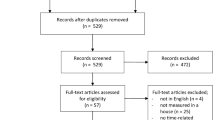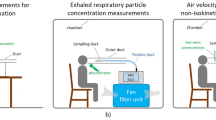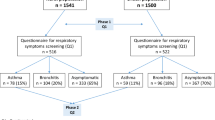Abstract
A total of 81 randomly selected elementary school teachers participated in two sampling campaigns conducted 2 weeks apart during the winter. A 24-h sample collection was performed using personal and microenvironmental sampling from homes, and an 8-h sample collection was performed from workplaces of the studied subjects. Filters were analyzed for particle mass, absorption coefficient of the filter, and for both total and viable microorganisms. Comprehensive questionnaire responses were collected from the teachers concerning weekly occurred symptoms during the previous 12-month period, and they filled in symptom diaries immediately after each sampling campaign concerning symptoms during the previous 24-h and 7-day periods. The effect of different recall periods on agreement between questionnaire responses was assessed. Factor analysis was used in order to identify factors explaining the pattern of correlations within the personal, home, and work measurements. Moreover, associations between personal, home, and work measurements of pollutants and symptoms were analyzed using general estimation equations. The recall period of 7 days seemed to provide the most reliable data for the health effect assessment. Information from the factor analysis may allow reduction of variables related to the exposure assessment, and better interpretation of results. Both personal exposure and concentrations of pollutants at home were more frequently associated with health symptoms than concentrations at work. In multipollutant analyses, absorbance coefficient was positively associated with eye symptoms, and total bacteria with both cough and blocked nose.
This is a preview of subscription content, access via your institution
Access options
Subscribe to this journal
Receive 6 print issues and online access
$259.00 per year
only $43.17 per issue
Buy this article
- Purchase on Springer Link
- Instant access to full article PDF
Prices may be subject to local taxes which are calculated during checkout
Similar content being viewed by others
References
Andersson K. Epidemiological approach to indoor air problems. Indoor Air 1998: 8 (Suppl. 4): 32–39.
Brunekreef B., Dockery D.W., and Krzyzanowski M. Epidemiologic studies on short-term effects of low levels of major ambient air pollution components. Environ Health Perspect 1995: 103 (Suppl. 2): 3–13.
Bornehag C.G., Blomquist G., Gyntelberg F., Jarvholm B., Malmberg P., Nordvall L. et al. Dampness in buildings and health. Indoor Air 2001: 11 (2): 72–86.
Chelelgo J., Haverinen U., Vahteristo M., Koivisto J., Husman T., Nevalainen A. et al. Analysis of moisture findings in the interior spaces of Finnish housing stock. J Air Waste Manage Assoc 2001: 51 (1): 69–77.
Dales R.E., Miller D., and McMullen E. Indoor air quality and health: validity and determinants of reported home dampness and moulds. Int J Epidemiol 1997: 26 (1): 120–125.
Fung F., and Hughson W.G. Health effects of indoor fungal bioaerosol exposure. Appl Occup Environ Hyg 2003: 18: 535–544.
Hirvonen M.-R., Ruotsalainen M., Savolainen K., and Nevalainen A. Effect of viability of actinomycete spores on their ability to stimulate production of nitric oxide and reactive oxygen species in RAW264.7 macrophages. Toxicology 1997: 124: 105–114.
Hälinen A.J., Komulainen H., Salonen R.O., Ruotsalainen M., and Hirvonen M.-R. Diesel particles induce nitric oxide production in murine alveolar macrophages and rat airways. Environ Toxicol Pharmacol 1999: 7: 11–18.
Hänninen O.O., Palonen J., Tuomisto J.T., Yli-Tuomi T., Seppänen O., and Jantunen M.J. Reduction potential of urban PM2.5 mortality risk using modern ventilation systems in buildings. Indoor Air 2005: 15 (4): 246–256.
Koskinen O.M., Husman T.M., Meklin T.M., and Nevalainen A.I. The relationship between moisture or mould observations in houses and the state of health of their occupants. Euro Respir J 1999: 14 (6): 1363–1367.
Kurnitski J., Palonen J., Engberg S., and Ruotsalainen R. Koulujen sisäilmasto—rehtorikysely ja sisäilmastomittaukset (Indoor Environmental Quality in Schools — Questionnaire Study and Environmental Measurements, in Finnish, Abstract in English), Vol. B43. Publications of Helsinki University of Technology, Espoo, Finland, 1996.
Lacey J., and Crook B. Fungal and actinomycete spores as pollutants of the workplace and occupational allergens. Ann Occup Hyg 1988: 32 (4): 515–533.
Matthias-Maser S., and Jaenicke R. Examination of atmospheric bioaerosol particles with radii >0.2 μm. J Aerosol Sci 1994: 25 (8): 1605–1613.
Mikatavage M.A., Rose V.E., Funkhouser E., Oestenstad R.K., Dillon K., and Reynolds K.D. Beyond air quality — factors that affect prevalence estimates of sick building syndrome. Am Ind Hyg Assoc J 1995: 56: 1141–1146.
Ott W.R. Concepts of human exposure to air pollution. Environ Int 1982: 7 (3): 179–196.
Patovirta R. Teachers' health in moisture-damaged schools — a follow-up study. Academic Dissertation, Vol. A5. Publications of National Public Health Institute, Kuopio, Finland, 2005.
Peat J.K., Dickerson J., and Li J. Effects of damp and mould in the home on respiratory health: a review of the literature. Allergy 1998: 53 (2): 120–128.
Pirhonen I., Nevalainen A., Husman T., and Pekkanen J. Home dampness, moulds and their influence on respiratory infections and symptoms in adults in Finland. Eur Respir J 1996: 9: 2618–2622.
Pope C.A., Dockery D.W., and Schwartz J. Review of epidemiological evidence of health effects of particulate air pollution. Inhal Toxicol 1995: 7: 1–18.
Roponen M., Toivola M., Alm S., Nevalainen A., Jussila J., and Hirvonen M.-R. Inflammatory and cytotoxic potential of the airborne particle material assessed by nasal lavage and cell exposure methods. Inhal Toxicol 2003: 15: 23–38.
Spengler J.D., and Soczek M.L. Evidence for improved ambient air quality and the need for personal exposure research. Environ Sci Technol 1984: 18: 268A–280A.
Toivola M., Alm S., Reponen T., Kolari S., and Nevalainen A. Personal exposures and microenvironmental concentrations of particles and bioaesols. J Environ Monit 2002: 4: 166–174.
Toivola M., Alm S., and Nevalainen A. Viable fungi and bacteria in personal exposure samples in relation to microenvironements. J Environ Monit 2004a: 6: 113–120.
Toivola M., Alm S., and Nevalainen A. Personal exposure to particles and microbes in relation to microenvironmental concentrations. Indoor Air 2004b: 14 (5): 351–359.
Toivola M., Alm S., Roponen M., Hirvonen M.-R., and Nevalainen A. Determinants of personal exposure to particles and microbial aerosol (Submitted).
Verhoeff A.P., and Burge H.A. Health risk assessment of fungi in home environments. Ann Allergy Asthma Immunol 1997: 78 (6): 544–554.
Wallace L. Indoor particles: a review. J Air Waste Manage Assoc 1996: 46: 98–126.
Acknowledgements
This study was financially supported by the Academy of Finland and the Finnish Work Environment Fund.
Author information
Authors and Affiliations
Corresponding author
Rights and permissions
About this article
Cite this article
Haverinen-Shaughnessy, U., Toivola, M., Alm, S. et al. Personal and microenvironmental concentrations of particles and microbial aerosol in relation to health symptoms among teachers. J Expo Sci Environ Epidemiol 17, 182–190 (2007). https://doi.org/10.1038/sj.jes.7500494
Received:
Revised:
Accepted:
Published:
Issue Date:
DOI: https://doi.org/10.1038/sj.jes.7500494
Keywords
This article is cited by
-
A Critical Review of Current Imaging Techniques to Investigate Water Transfers in Wood and Biosourced Materials
Transport in Porous Media (2021)
-
Assessment of airborne bioaerosols in korean apartment houses
Toxicology and Environmental Health Sciences (2010)



